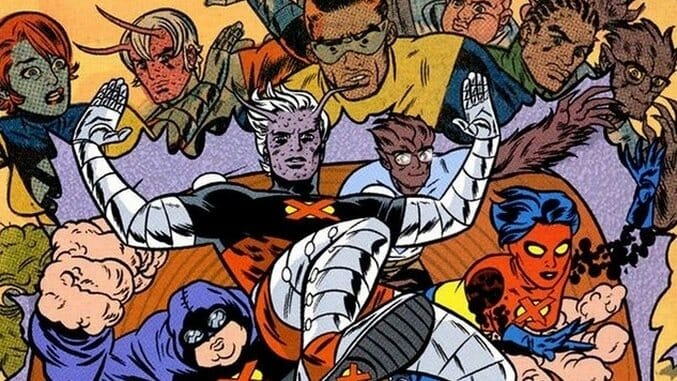Marvel’s Merry Mutant Suicide Squad: X-Statix at 15
Main Art by Mike Allred
DC’s rebirthed Suicide Squad from writer Rob Williams and tag-team artists Philip Tan and Jim Lee is expertly crafted to appeal to fans of the critically maligned but commercially successful film—the team line-ups are nearly identical, comic characters have been redesigned to better match their film counterparts and at least one popular trailer sequence appears “verbatim” in the first issue—which makes this latest volume, however well executed, utterly antithetical to the Suicide Squad concept, and perhaps the least “Suicide Squad-y” Suicide Squad of the last fifteen years.
While director David Ayers’ film owes the bulk of its inspiration to the New 52 iteration of the Squad that launched with heretofore-unrelated character Harley Quinn front and center, the no-return mission that created the property came from writer John Ostrander and artist Luke McDonnell way back in 1987. Ostrander’s 68-issue run, much of it co-written with Kim Yale, elevated c-listers like Deadshot and Captain Boomerang to leading-man status, while examining the motivations and personal lives of career criminals in the DCU. It was also unafraid to clean house, regularly offing backlist baddies and even prominent team members like Rick Flag, Jr., creating an ever-present no-one’s-safe tension.

Suicide Squad Vol. 1 #1 Cover Art by Howard Chaykin
The modern Suicide Squad, rebooted for the New 52 in 2011 and soft-relaunched again in 2014 as New Suicide Squad, suffered from a popularity problem. Its cast, rather than being comprised of expendable nobodies, was front-loaded with popular villains with ties to major franchises. The old Squad had no problem mowing down Firestorm villains, but how many Batman rogues is DC really willing to part with?
The result was a severe case of the Redshirt trope, where the killable members of the team were apparent upon introduction. There’s little shock to be had when Lime, Voltaic or Yo-Yo meet grisly ends, and plenty of (rightful) disbelief when Harley, Deadshot or conscripted heroes like Steel and Power Girl are “presumed dead.” New Suicide Squad fared even worse: after two years, major-league villains Black Manta, Parasite and Cheetah emerged unscathed while the Hunky Punk—the Hunky Punk —ate a bullet.

New Suicide Squad #1 Cover Art by Jeremy Roberts
This latest volume will face the same challenge: how do you sell readers on the promise of a high-risk, expendable team when most of the cast isn’t really expendable? What we have instead is an emphasis on the “Squad” and a shuffling aside of the “Suicide.” Rather than an unpredictable clearing-house for surplus villains, the modern Suicide Squad is a team-up book for popular baddies, most of whom won’t be killed, or at least won’t stay dead for long.
While the Suicide Squad comic may be moving farther and farther from its deadly roots, 2016 marks the 15th anniversary of the closest spiritual successor that the Ostrander/Yale/McDonnell Suicide Squad run has ever received (aside from Michel Fiffe’s stellar, self-aware homage, COPRA). Peter Milligan and Mike Allred’s X-Force, later re-titled to X-Statix, launched in July 2001 as part of the Grant Morrison/Frank Quitely-led X-revolution, ejecting the existing X-Force squad of paramilitary former New Mutants in exchange for reality-TV mutant heroes with no qualms about killing—and a tendency to get killed.
-

-

-

-

-

-

-

-

-

-

-

-

-

-

-

-

-

-

-

-

-

-

-

-

-

-

-

-

-

-

-

-

-

-

-

-

-

-

-

-












































